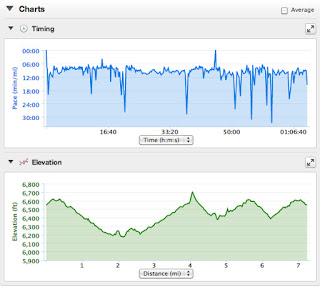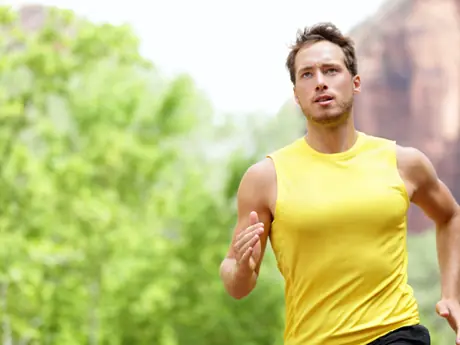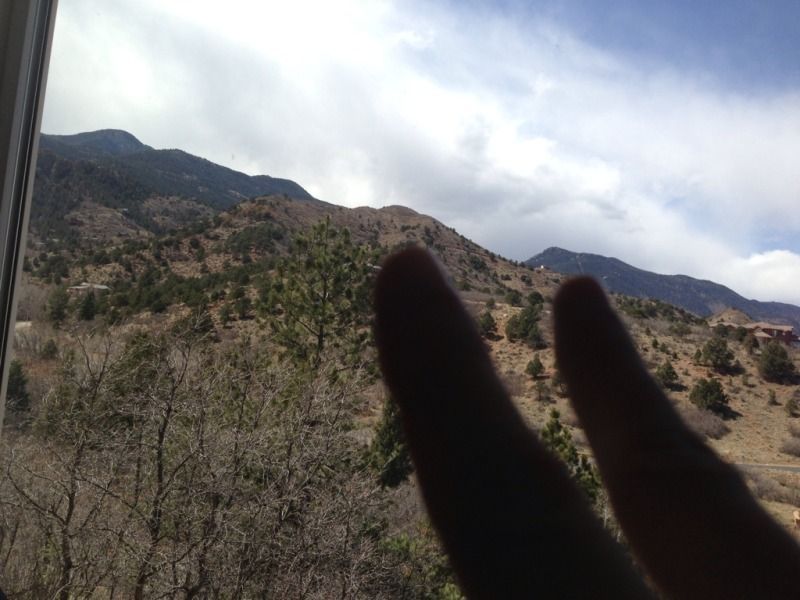Before we get to the article, about 3months ago I moved to >6,000ft of elevation from sea level. I wanted to think that I would work hard to acclimate to
1. The change in air pressure (it's not a difference in O2 content, as is commonly thought).
2. The hILLs ;). A simple road commute to work is a ~10miles run with almost a 1/2 mile of cumulative UP. This is with start and stop points differing by a few hundred feet of elevation, so the rolling hills are what's doing it. It's not just rolling, i can leave my house and run ~15miles and be at the top of pikes peak with a cumulative climb of 10,000'!
3. The god-send, aridness! Being from the midatlantic, the concept of convective cooling is not in our vocabulary. In order for sweat to cool you evapoartively, the atmosphere has to be able to be capable of taking on more water. This is usually directly linked to the dew point. Running in humidity is like growing a new limb. A cool day you send vast amounts of blood to your working muscles. In heat+humidity it's your skin that gets priority. The biggest organ in my body (sorry Mrs Paleorunner, I mean my skin) needs the most blood first!
During this 3month process, there's been moving and a new job cutting into my training a bit. But I finally had a chance to compare my fitness a little (albeit unscientifically). I was in Florida for business and I thought, aha - more air pressure, NO hills I should blaze through a run. Then, the heat+humidity had a different plan for me :). But I was able to maintain a zone 2,3 run at my 6month ago marathon pace for ~7miles. Good sign as it was relatively easy. Then after 5 days in FL, back to colorado on the relatively flat trails behind my house. Let's compare my performance. (same runner, same shoes, days apart, same relative perceived effort (RPE))
Colorado:
Distance: 7.45 miles
Pace: 9:41 / mile
Cumulative Elevation Ascent: 1600 feet
 Temp/Humidity: 79 F / 23 %
Temp/Humidity: 79 F / 23 %
Florida:
Distance: 8.61 miles
Pace: 7:19 / mile
Cumulative Elevation Ascent: 25 feet
Temp/Humidity: 82 F / 80 %
Heat is a big factor, but running uphill is bigger!
Now on to the fact/fiction from Active.com:
By Karen Mirlenbrink • For Active.com
Many athletes use altitude-training programs to enhance their physical performance. However, utilizing these concepts for fitness purposes can be a little tricky. Here are some of the common thoughts, right or wrong, regarding high-altitude training and how it can help or hurt you in your fitness pursuits.
Training at altitude is beneficial because the air is thinner.
FICTION
It’s not the lack of oxygen that makes your body work so hard at altitude. It really has to do with the barometric pressure. Even at 10,000 feet, there is still 29 percent oxygen in the air, and out of that 29 percent you only take in around 10 percent of the oxygen you breathe. The big challenge is your ability at altitude to extract the oxygen and get it into your bloodstream at altitude.
More: The Effects of High-Altitude TrainingAt sea level, your body uses air pressure to its advantage. It allows all of the weight from the atmosphere to help push the air into your lungs, moving the air from an area of greater pressure to lower pressure.
The same happens at a cellular level, where the pressure then allows the air (including oxygen) to be pressed into your bloodstream.
When you work at a place that is higher than sea level, you start to experience less barometric pressure. Thus the air is not forced into the bloodstream as easily, making the body work harder.
Over time, the body will grow more red blood cells to help ease the struggle of getting oxygen. These cells help carry oxygen through the body, which will result in better fitness/sports performance.
Training at altitude will make me more fit.
FACT
Professional and Olympic athletes have known the benefits of altitude training for years. After all, there is an Olympic Training Center in Colorado Springs, Colorado, for a very good reason. If someone trains at altitude, they will see improvements in their maximal oxygen uptake (the ability to take oxygen in and move it into the blood stream), increased lactate threshold (the ability of the body to get over the “burn”), improved power output, and better sleep (which helps repair the body). These benefits are all a result of the red blood cell production caused by the adaptation to low-barometric pressure.
If I train with a mask that restricts airflow, it will simulate training at altitude.
FICTION
As stated before, the benefits of altitude training are not found from areas that lack oxygen, but from areas of lower-barometric pressure. Restricting airflow does not simulate training in altitude. In fact, training with reduced oxygen can cause serious problems like hyperventilation, disorientation, rapid heartbeat, elevated blood pressure and loss of consciousness.
Better use of altitude training would be sleeping in a hyperbaric tent. These tents create an enclosed, simulated altitude that allows the body to see results of altitude training while residing at sea level. These tents can be purchased or rented and assembled in your own bed. Some places offer hyperbaric chambers that you can visit for a fee. The “altitude” is adjusted slowly as the body adapts, and it has been proven to yield positive results.
Though air-restrictive masks may prove beneficial for some athletes whose sport requires working with low-oxygen levels, the masks pose danger to those using them to "get fit.”
If I train at altitude, then race at sea level, I’ll see better performance.
FACT
Well, this is a tricky one. Depending on the environment, it could backfire on you. If you spend time training in Colorado, which is high and very dry, then do a marathon in Florida, which is low and very wet; you may experience some problems because of the humidity. However, generally, you should see better times, strength and recovery if you train at altitude (or simulated altitude), and then perform at sea level.
If I train at sea level and plan to do a race in the mountains, then it’s probably a good idea to get there a few days early to prepare for the race.
FICTION
When you’re not accustomed to altitude, you have two choices: do the race immediately—within a day—or wait 7 to 10 days before racing. If you get to an event a couple of days before, your body has time to figure out that you are in a different environment, and then it will start making the necessary changes it needs to survive at altitude. Your body will become stressed, and then it will show in your performance.
If you do the event immediately, it will not have time to start adapting, and you should not see terrible challenges to your pulmonary system. If you get there 10 days ahead of time, your body will have plenty of time to fully acclimate.








